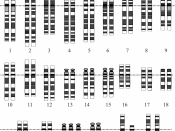The chromosomal abnormality involved in most cases of Down syndrome is trisomy-21, or the presence of three copies of the 21st chromosome. As a result, the affected person has 47 chromosomes in all body cells instead of the normal 46, although how this causes the condition's symptoms is not yet known. Scientists assume that the reason for the abnormal chromosomal assortment is the fertilization of an ovum having 24 chromosomes by a sperm with a normal assortment of 23, but they have also found that the sperm can carry the extra chromosome as well. The abnormal ovum or sperm is derived from a germ cell in which the pair of 21st chromosomes holds together and passes into the same sperm or ovum instead of separating. In the type of Down syndrome called translocation, the extra chromosome 21 material is attached to one of the other chromosomes; when some, but not all, of the body's cells carry an extra chromosome 21, the condition is a type of Down syndrome called mosaicism.
Because of the extra chromosome 21, children with Down syndrome often have some characteristic physical features, such as a small head, a flat face, slightly upward slanted eyelids, skin folds at the inner corners of the eyes, small nose and mouth, and small hands and feet. Most of these characteristic do not interfere with the child's functioning, a doctor primarily uses the characteristics for diagnostic purposes. These physical features are variable, and children with Down syndrome are usually more like other children than they are different.
Individuals with Down syndrome also often have certain medical conditions such as weak muscles, neurological impairments, heart disease, intestinal abnormalities, poorly functioning thyroid gland, eye abnormalities, hearing problems, and skeletal problems. Almost all children with Down syndrome are mentally retarded, in the...


